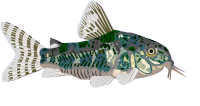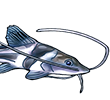da Silva Marques, R, I Ohara, & OA Shibatta, 2025, Cephalic musculature of the Pacman catfish Lophiosilurus alexandri Steindachner, 1876 (Siluriformes, Pseudopimelodidae). Journal of Morphology 286: e70056.
Abstract
The cephalic musculature of the Pacman catfish Lophiosilurus alexandri (L. alexandri) is described and compared with Pimelodus maculatus, Pimelodus microstoma, Pseudopimelodus mangurus (P. mangurus), Batrochoglanis labrosus (B. labrosus), and Lophiosilurus fowleri (L. fowleri). Besides the distinguished Pacman catfish head shape, which is strongly depressed, broad, and with a large mouth, we hypothesize that the gross morphology of the musculature is related to the phylogenetic background. A phylogenetic analysis of selected characters evidenced three putative synapomorphies for the family Pseudopimelodidae, three for the subfamily Batrochoglaninae, three for the genus Lophiosilurus, two autapomorphies for L. alexandri, one for L. fowleri, one for B. labrosus, and five for P. mangurus. The absence of the retractor tentaculi is interpreted as a putative synapomorphy of Pseudopimelodidae and Pimelodidae. The rounded adductor mandibulae emerge as the predominantly voluminous musculature in L. alexandri and other Pseudopimelodidae, a conspicuous synapomorphy of the family. Profound differences were observed when comparing the cephalic musculatures of L. alexandri with Lophius piscatorius and Chaca bankanensis, which are unrelated species with similar body morphology and ambush behavior. The morphology of cephalic musculature highlights the plasticity of the musculature function and the closer relationship with the phylogenetic history of species and lineages.
Head muscles of the pacman catfish
- Silurus
- Posts: 12475
- Joined: 31 Dec 2002, 11:35
- I've donated: $12.00!
- My articles: 55
- My images: 902
- My catfish: 1
- My cats species list: 90 (i:1, k:0)
- Spotted: 432
- Location 1: Singapore
- Location 2: Moderator Emeritus





